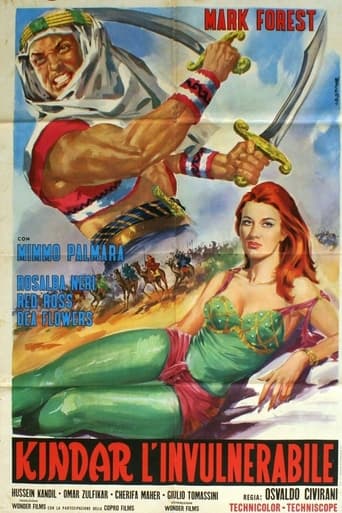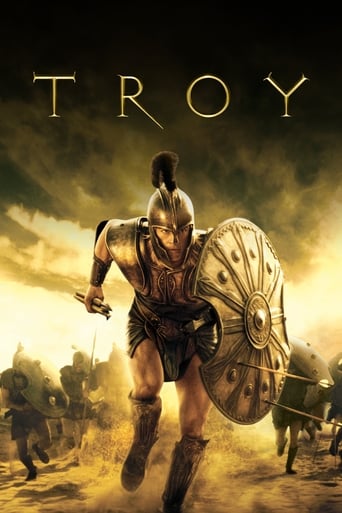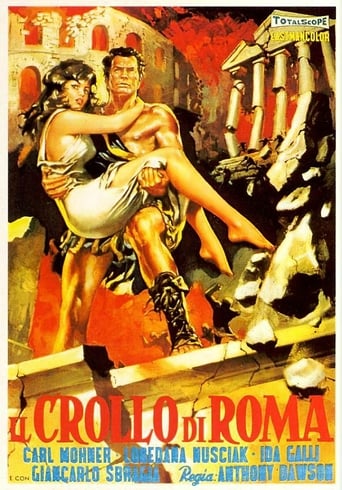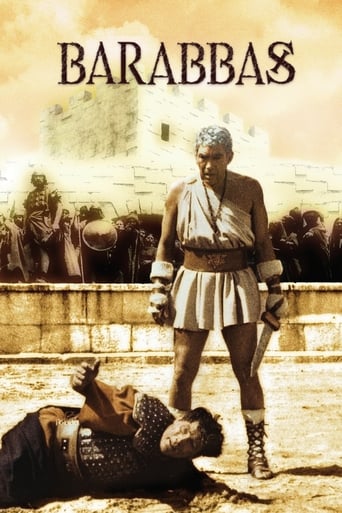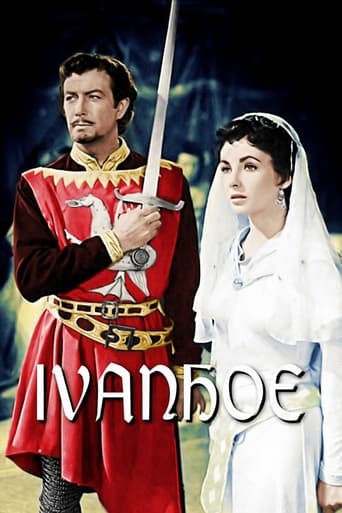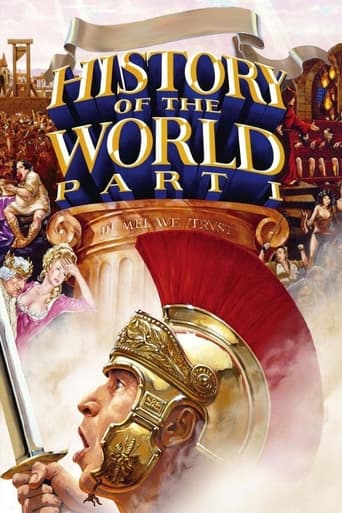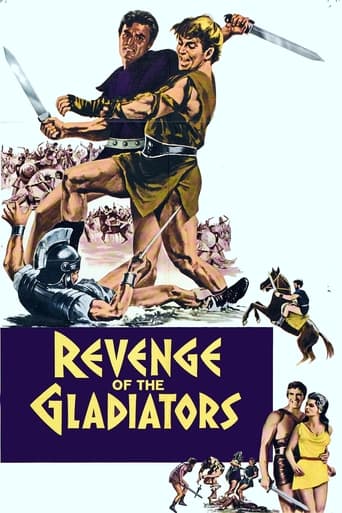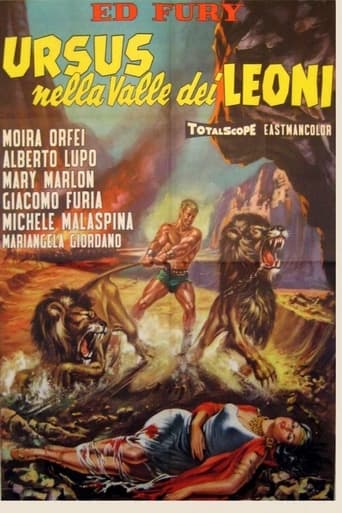
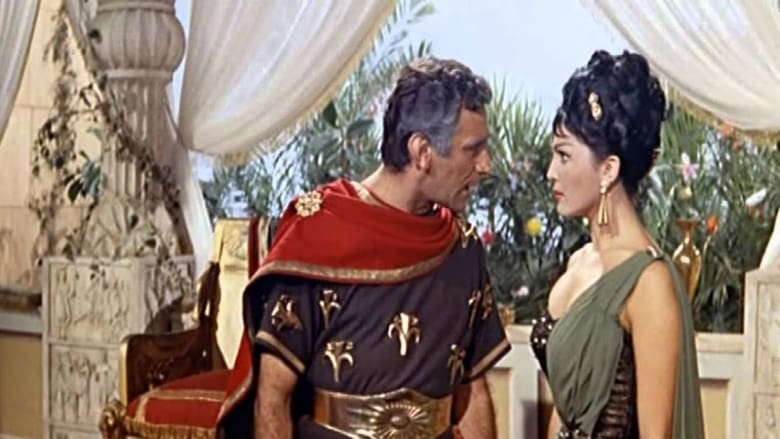
Ursus in the Valley of the Lions (1961)
Bodybuilder Ed Fury stars as the legendary Ursus in this above-average sword-and-sandal adventure from veteran director Carlo Campogalliani. The plot concerns Ursus' attempts to rescue his kidnapped fiancee, aided by a pretty blind slave girl. Now an evil queen, Ursus' former love throws him into a gladiatorial arena with a bull, which manages to smack the slave girl in the head and restore her eyesight before Ursus defeats it and his enemies. The bullfight is particularly well-staged, and this exciting spectacle may be the highlight of Fury's erratic screen career. ~ Robert Firsching, Rovi
Watch Trailer
Cast
Similar titles
Reviews
Touches You
A Disappointing Continuation
It was OK. I don't see why everyone loves it so much. It wasn't very smart or deep or well-directed.
By the time the dramatic fireworks start popping off, each one feels earned.
At some point in ancient history Generic Power Mad Usurper conquered Generic Greek CityVilleopolis and King Rightful Ruler was slaughtered. But not before Lil' Prince Trouble-Waiting-To-Happen...er I mean Ursus was spirited away by his mom and a couple ladies-in-waiting. Mom and the gang made it about as far as the parking lot behind the studio before they were fallen upon by the Usurper's men. Since they were escaping during a siege neither mom nor her guards thought to bring any weapons and are quickly butchered, except young Ursus, whose horse runs away with him attached. Eventually he is found by a pride of lions. Instead of turning him into a mid-day snack, they decide to raise him as one of their own. This is shown by a wipe type effect where a shot of a lion licking an infant's face (did they actually let a real lion lick a real infant's face!!??) is replaced by a shot of a lion licking a grown and strapping Ursus' face.Ursus spends most of his time frolicking with his lion friends, yanking their tails and shouting" HO SO YOU THINK YOU'RE STRONGER THAN URSUS? HAHA!" Yet the lions let him live. This would have never gone over in my family, not that seeing this movie as a kid influenced me to behave in any like manner. No way. Not me.So Ursus lives a simple life which he really seems to enjoy until one day while out hunting he finds in his pit trap, not dinner, but a slavers wagon, loaded down with some sweet looking slave girls and their slave trader.Ursus hauls the wagon out of the pit and exchanges googly eyes with one of the slave girls. They have a real Hubba Hubba moment and Ursus decides to throw her over his shoulder and haul her off to his cave. The slave trader doesn't want to lose good product do he follows Ursus to the Cave of Lions, where he is scared spitless by a Cave full of lions. He demands payment and Ursus, not knowing what money is, offers one of his lions as a trade for the girl. The slaver is less than enthused until he sees an amulet, an amulet that was given to Ursus by his father right before he died, an amulet that is in reality...THE ROYAL SEAL! The slaver knows he can get a pretty denari for that, so he offers to take it off Ursus' hands. Ursus agrees and off the slave trader goes to sell the Seal in the Big City.The slave girl is charmed by Ursus' simple honesty, massive physique and inexplicably well groomed hair and teeth and decides to stay with him, despite the fact that the only furniture in her new house is a rock, some elk bones and some lion poop.But their rustic happiness can't last forever. Eventually the Royal Seal falls into the hands of the Usurper, who fears Ursus will one day visit some poetic justice on his behind, and sends his soldiers out to kill our hero. They fail of course, probably because ancient despots didn't have access to modern human resource-style motivation and training techniques. They do manage however to kidnap Ursus' lady and kill most of his lion friends with poison meat. (Because lions are immune to arrows) I'll leave the rest of the movie a surprise, although I will say Ursus spends it rescuing his honey and avenging the death of his father, mother and lion friends. He fights tons of soldiers, a pack of trained killer hyenas and a herd of elephants among other things. Although it would have been really funny if the writers added a little more "fish out of water" humor when Ursus was learning about civilization, overall this was a very entertaining peplum. It's absolutely worth your time and shekels
The second film in Ed Fury's "Ursus" trilogy, (though there's little in the way of story-line to connect the three movies), begins with an obligatory setting-the-scene prologue which establishes the infant Ursus as the true heir of a kingdom overrun and conquered by a villainous barbarian. Though faithful subjects manage to smuggle the infant Ursus out of the besieged city in a basket, the basket tumbles into the lair of a pride of lions and the lost heir soon becomes nothing more than the subject of wistful rumor and legend. Mercifully the movie quickly jumps forward to the adult Ursus, now grown into a strapping though naive young man who learned his language skills from men in passing caravans. Up to this point the second "Ursus" movie has shown little promise, primarily because the lions which raised our hero look and act like lethargic, second-rate sideshow attractions rather than wildly magnificent Kings of the Beasts. Then we have a routine sequence in which Ursus acquires a slave girl from a passing trader. However, once the evil usurper learns that the rightful occupant of his throne is alive in the land, various elements of the movie finally come together to create a lively and entertaining entry in the sword-and-sandal cycle. One element worth noting here are the two "beefcake-bondage" sequences which are among the best such sequences to be found in the whole gamut of this genre. In the first, a peplum-wearing Ursus -- played, of course, by Ed Fury -- stands as a captive in the usurper's court. A length of wood, (perhaps too thin for this purpose), has been bound to the backs of his outstretched arms. Chains around his wrists and ankles are held by nervous-looking soldiers. Other soldiers guard him with spears pointed menacingly toward him. The usurper taunts him but Ursus remains defiant. Later, having been taken to a torch-lit dungeon, the sweaty Ursus stands with outstretched arms chained to the stone walls. That wooden pole has been removed from his shoulders but a metal ring now encircles his neck and a chain attached to this ring leads up to the ceiling. Two long pieces of wood are fitted around his ankles, preventing him from kicking or changing position. Fury, about 32 or 33 years old at this time, is only ever-so-slightly past his prime -- his waist looks a bit thick -- but he's still a compelling hunk of manhood and his bondage poses are of iconic quality. What's more, his nipples are dark and sharply-defined against his skin. Unfortunately, there's no actual torture here, unlike the other two Ursus movies in which a series of whiplashes play a symphony of pain on Ed Fury's bare back as he's forced to turn grindstones. (As other reviewers have pointed out, the print under discussion here has lamentably faded into muddy-looking sepia tones.)
"Ursus nella valle dei leoni" (1961) cannot compete with some of the better known muscle man movies starring Steve Reeves, Mark Forest, Gordon Scott, Alan Steel, and Reg Park. Nevertheless, this tyrant-versus-a-strongman saga with Ed Fury in the title role ranks a notch above the usual run-of-the-mill peplum potboilers. At best an uneven but entertaining epic, this first part of this adventure opus opens with an expository prelude with a kingdom being overrun by barbarians, then relies on comedy in its first half before it reverts during its second half to the standard he-man heroics about the lost son of a ruler who topples the murderous miscreant (Albert Lupo of "Herod the Great") who ran Ursus' unarmed father through with a sword, ascended the throne, and then enslaved the population. Invaders attack the kingdom but baby Ursus survives the sword after his mother packs him off to safety in a basket on horseback. Soldiers attack the queen and her minions and she skewers herself with a sword before they can take her. The safety proves to be short-lived for Ursus, and the basket containing future warrior falls off the horse during flight. Ursus winds up alone in the wilderness surrounded by a den of lions that nurse him. Sound far-fetched? Of course, it is! However, "Ursus in the Valley of the Lions" is no more outlandish than the actual legend about the brothers Romulus (Steve Reeves) and Remus (Gordon Scott) who founded Rome in director Sergio Corbucci's classic "Duel of the Titans" (1961), where wolves supposedly nursed the brothers to maturity. Wisely, seasoned Italian director Carlo Ludovico Bragaglia, who also helmed a lesser Hercules movie "The Loves of Hercules" (1960) and the Victor Mature ancient military yarn "Hannibal," dwells only momentarily on Ursus' unusual childhood. Imagine a lioness changing diapers, much less nursing a squalling infant, and you can understand why Bragaglia leaps forward to Ursus as an adult. In a sense, Ursus has more in common with Tarzan of the Apes than Hercules, Samson, or Ulysses. Whatever the case, Ursus' idyllic life among the big cats changes for the worst when a wagon transporting a load of female slaves blunders into one of the strongman's animal traps and loses a wheel. The strongman has to push their vehicle single-handedly out of the pit. Ursus takes a shine to one of the maidens and she stays behind while the rest head off to the kingdom. The tyrant who sits on the throne learns about Ursus from a medallion that one of the slave girls has and realizes the threat that he poses to him if the public should learn about him. The ruler dispatches his bow & arrow toting soldiers to the lions' den, and they poison all the lions with tainted meat and capture Ursus with a net. Indeed, the villain here is a dastard! Mind you, Ursus knows nothing of all this intrigue and would have preferred to have lived out his life in blissful ignorance until the evil king intruded into his affairs. The action shifts gears from comedy to adventure after the villains put Ursus into chains and imprison in a dark cell. The ruler doesn't want anybody to get wind of who Ursus really is and even offers to free him if the strongman will keep silent about his heritage. Eventually, Ursus manages to escape with the help of a palace insider and finds his way out of a den of hyenas. In the execrable, full-frame, Sinister Cinema black & white print that I own of this movie, you cannot tell the difference between Ed Fury and the animal trainer and that is a plus. Ed Fury or the animal wrangler--when either shares scenes with the beasts--doesn't battle with a stuffed lion's head like Mark Forest did in "Son of Samson." The hyena scenes in the prison are pretty creepy, too. Ed Fury's Ursus doesn't go around hurling giant rocks, battling mythical entities, or collapsing architecture, but he is splendidly dubbed with a loud voice that never leaves you in doubt about what he says. The villains are worthy enough to make Ursus' struggle a challenge. Incidentally, this was Ed Fury's second film as a muscle bound hero after "Colossus and the Amazon Queen" (1960). Ruggero Deodato, who later helmed such exploitation classics such as "Jungle Holocaust" and "Cannibal Holocaust," handled second unit directing duties on this movie, too.
The print I saw was a very worn black and white one from Sinister Cinema and as the film went on it rapidly became clear that the print's lack of quality and color work against real enjoyment of the film.The good king and queen of some far off kingdom are brought down by an evil invader, however the queen escapes with their infant son. She soon commits suicide rather than be taken prisoner, but does so only after getting the baby away. The baby ends up being raised by lions. Years later the adult Ursus ends up captured by the evil king who killed his parents and moves to prevent him from ever taking the throne. There's more to it than that but it at least gives you the basic idea of the plot.The movie is a step or two above the normal sword and sandal film thanks to a largely knowing translation that has Ursus speaking of wanting to become the special friend of a slave girl he's carried off. I know you're saying why would Ursus carry off a slave girl, simple he was raised by lions. The acting isn't bad and the translation seems to match the lip movements.Is this a movie your going to watch over and over again? Probably not but should you run across it on TV late one night you'll find yourself entertained.



